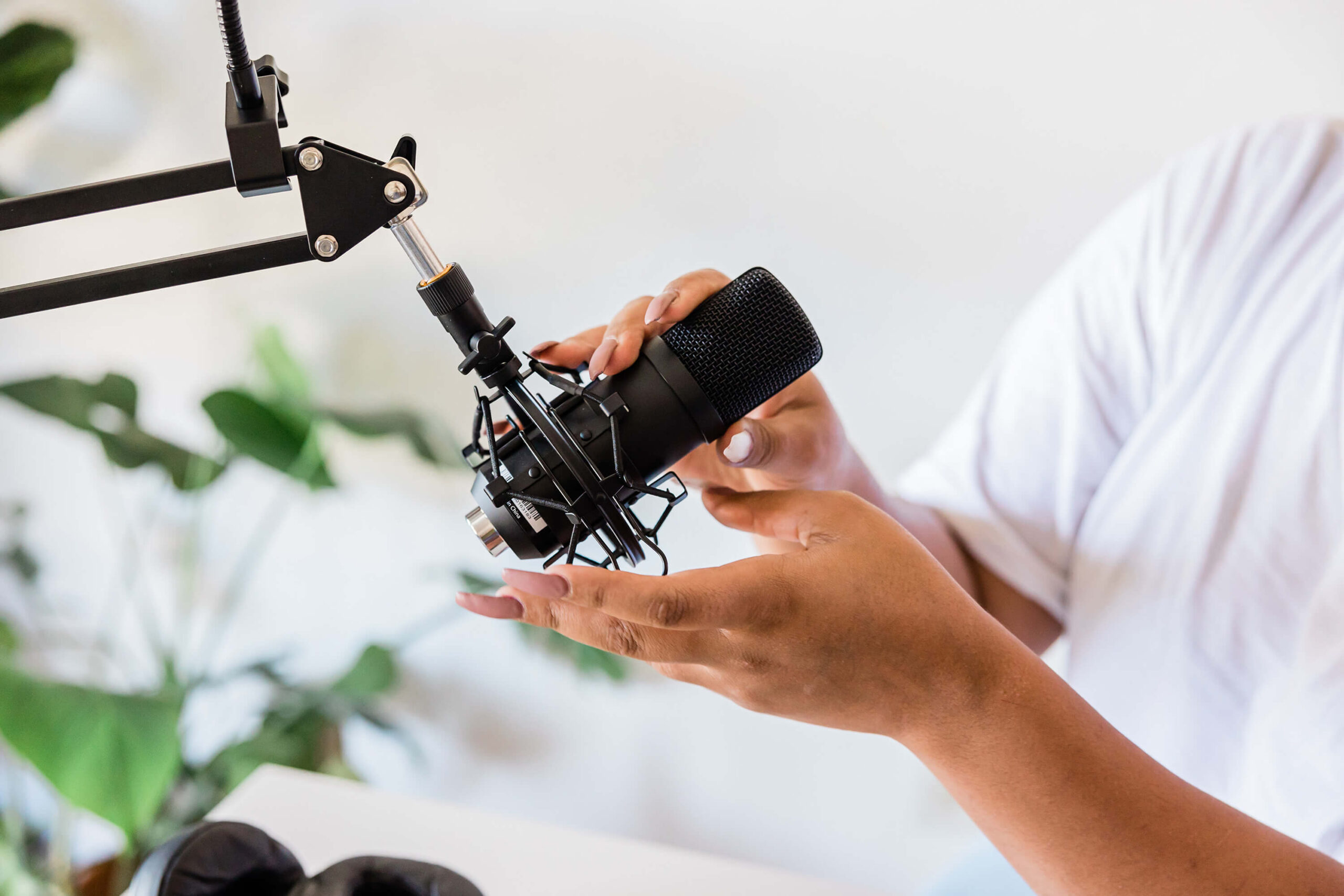Wow, what a week. Since Apple’s Spring Loaded event on April 21, there have been a record number of major updates from the biggest names in podcasting. (Apple, Spotify, and…Facebook?)
So today, my goal is to share the most critical updates to help you understand how this will affect you as a current or aspiring podcaster.
✔️ How does Apple’s new paid podcast subscription option work? And what does it mean for your free show?
✔️ What did Spotify and Facebook announce in response to Apple’s big announcements? (Hint: both are about in-app creator monetization options)
And perhaps the biggest question…
NOTE: This podcast was transcribed by a free AI tool called Otter. Please forgive any typos or errors.
Melissa Guller:
Can I first say, what a week! Between April 21 and April 28, the day this episode will go live, I feel like there have been more podcast industry announcements than I can even keep up with. So today, my goal is to share the most critical updates, including a spotlight focus on Apple’s huge introduction of Apple Paid Subscriptions. I’ve done the research so I can give you the key info you’ll need to understand how this will affect you as a current or aspiring podcaster.
But Apple wasn’t the only big name to make headlines this week. Spotify and Facebook have also released major announcements about audio experiences, podcast integrations, and creator monetization, so I had to fully re-record this episode at the 11th hour to give you my best attempt at a complete update.
And by the way, I have links to half a dozen articles in the complete show notes at witandwire.com/34 in case you want to read more about any of the announcements featured in today’s episode.
Let’s start off by asking the big picture question and getting on the same page: what did Apple announce, and why is it such a big deal?
For this, I’m going to share information I’ve read directly from Apple’s press release on April 21, so here are the three main features coming out by May 2021:
#1 – An online hub for podcasters called Apple Podcasts for Creators
This site includes Apple Podcasts Connect, where you can manage your RSS feed, and they’ve also added more analytics and a few more helpful guides for podcasters. As an example, they have a few help articles on things like trailers, and how to use them, or embedding players.
To me, this is kind of interesting, but I don’t see a ton of new information or insights here. I’ll include a link in the show notes, but my favorite podcast hosting platforms like Buzzsprout and in particular Captivate are already providing these same analytics for me. And on top of that, the data you see in your hosting platform doesn’t only include Apple’s stats. I can also see the analytics from listeners on Spotify, from my embedded website players, and from all the tiny apps I’ve never heard of. So again, the link to my full comparison post on the top podcast hosting platforms at any budget is included in the show notes if you’re curious to learn more about that, but for today, I’ll just say that this announcement is interesting, but it’s mostly a necessity.
I say a necessity because Apple needed to update a lot of things to enable Apple Paid Subscriptions, since that requires new technology and things like payment processing and reporting. So we’ll get to all of that shortly, but to me, that’s where this update is coming from.
#2 – Apple Podcasts is releasing a major redesign of the listener experience for iOS 14.5.
Improvements to the listener experience are actually a huge deal for us podcast hosts, and here’s why. The easier something is to use, the more likely people are to stick around. And over the last 3-4 years, more people have started not only listening to podcasts for the first time, but choosing apps that aren’t Apple to do that listening.
Apple, obviously, doesn’t want that. Apple is a business, and at the end of the day, they want to get as many listeners using their app as possible. And with this redesign in particular, I really enjoyed a conversation from the Buzzsprout team where they pointed out that Apple’s new design looks much better, but it also looks nothing like the design or language you’ll find in other alternative listening apps, like Overcast. And they pointed out the fact that Apple isn’t targeting podcast junkies. They most likely designed this new experience with podcast newbies in mind, people who have never listened to podcasts before.
So as an example, here are two language shifts you’ll notice in the new Apple Podcasts interface.
First, as I shared in Episode 32, they have shifted from subscribing to a podcast to following a podcast. This is more in line with other social media platforms, but now – as predicted – Apple has decided that following a podcast is free to do, while subscribing to a podcast implies payment. More on that in a second.
But the other interesting language shift is from saying that you can download a podcast to instead saving a podcast. The word download originated from the fact that you did literally download audio files to your computer, the same way we all used to download mp3s from the internet before Spotify and streaming took over. So I think in this case, Apple’s decision to call it saving an episode for later makes way more sense, and is a lot more user friendly.
Before I talk about paid subscriptions, here are just a few more cool things about the redesigned listener interface coming out with iOS 14.5 in roughly May 2021. First, there’s an enhanced search tab, which should hopefully make it easier for people to find you, to browse the top charts and categories, and maybe make discoverability in-app even better.
Maybe you’ve heard me say before that I don’t think discoverability is very easy within Apple’s app right now. I think, you know, five years ago, more people would go to Apple search around, find their shows. And that’s how they discovered podcasts. But for the last few years, it hasn’t been that easy to navigate around the app. So usually you find your new podcasts elsewhere. A recommendation from a friend. You find somebody on Instagram, you realize that your favorite business owner has a podcast, you find something from Pinterest, there’s so many places where you can find podcasts. And you can think about how you discover shows, but very few people I know used to just go to Apple to find new podcasts. Now I think Apple is trying to make it easier to do that.
There’s another nice new feature called smart play, which is mostly helpful for serial shows. So what does that mean? A serial show is something that takes place chronologically, where you really need to listen to the episodes in order starting with episode one. On the other hand, most of our podcasts, including Wit & Wire are called Episodic podcasts, meaning that although we might release new episodes on a regular basis, you can really listen to them in any order. So what the smart play button does is it can identify that if your show is serial, which you indicate in your podcast settings, then it will play your podcast from Episode 1 and move along from there. It’s not the most showstopping feature, but I do think it’s pretty cool.
To sum up this whole point, which is big Apple update #2 around listener interface improvements, I’d say that I appreciate that Apple is making it easier for listeners to navigate around their app and continue listening to podcasts. Because the less friction listeners feel, the more likely they are to continue listening to our shows.
#3 – Apple Paid Subscriptions
That brings me to the biggest announcement of all, and the main topic I’ve been excited to get into this episode. And that’s the release of Apple Paid Subscriptions.
Here’s what it means. As a podcast host, you will now have three different podcast types to choose from when it comes to the way your show appears in Apple Podcasts specifically. First, it can stay a free podcast. I expect that this is what most people will do, and if that’s you, you won’t need to do anything differently. Free is the default.
Then the second type is a paid podcast. Listeners will have to subscribe to you show and pay you a small monthly fee in order to unlock access to your content. There are currently paid podcasts, particularly through networks like Luminary, but the huge difference here is the fact that Apple will now be able to process those payments. So imagine looking in your app and seeing a “Subscribe for $4.99/mo” button. Well if your credit card is already hooked up to your Apple account like I know it is, you can imaging how much more seamless this buying decision will be compared to asking someone to go to your website or your Patreon page, and then put in in their credit card, and then pay you. And to me, that’s actually the biggest benefit Apple has going for them with their new paid subscriptions option, which is the sheer ease of making a buying decision for the listener.
Now before I talk about numbers and earning and all of my favorite things, I wanted to circle back to podcast type number 3. Number one is a free podcast. Number two is a paid podcast. So number three is a hybrid, where some of your content is free, but something else you might offer is paid. Here are a few examples. First, maybe subscribers unlock access to extra bonus episodes. Second, maybe paid subscribers get access to the same episodes, but they’re ad-free. Third, maybe there are only five free episodes which act as a sampler, but in order to get the rest of the library, including the new releases, you need to become a monthly subscriber. Apple’s terms don’t dictate what you can and can’t do, so there are a ton of creative possibilities.
So at this point, I’ve shared the new podcast types. But we need to talk about earning potential here, and in particular, I want to compare Apple’s payout structure against Patreon. If you’ve never heard of Patreon, they’re one of many companies podcasters use to have members support their show on a monthly basis. So Apple Paid Subscriptions is a direct competitor for Patreon and a handful of other platforms.
With Apple, if you’re interested in enabling either partial or full paid subscription options for your podcast, you’ll need to pay $19.99 per year USD in order to have an account and unlock those features. To me, that’s totally reasonable. But then on top of that, Apple takes a cut of all subscriptions you earn. So if someone pays you $5/mo, Apple will take 30% of that money for that subscriber’s first year, and then 15% per year after that. It’s the same pricing model they’ve long used for apps in their app store, in case you’re curious about where those numbers came from.
And if you’re wondering if that’s a high percentage and you don’t want to do the math, please allow me to just share that the answer is….absolutely. By comparison, Patreon is free to use but they similarly keep a percentage of each payment, and their cut ranges from 8-12%, and there are small credit card fees on top of that. But to simplify, I’ll just say that Patreon is cheaper, and that I think expecting people to subscribe to your podcast for over a year to cut down the 30% to 15% is kind of insane.
But this is just the beginning of my big-picture question I’d like to pose. The question is, “Who is this the right fit for?” Because I think it’s pretty clear to see that earning subscriptions through Apple will be directly tied to not just the size of your listener base, but specifically the size of your listener base in Apple. So I think we should all be wondering….”Is it worth it?” or “Who is this worth it for?”
Let me first add another small logistical plot twist to help me build toward my answer. As I was doing research for this episode, I wondered more literally about how the paid episodes would need to be built. And the answer is that they have to be uploaded to Apple Podcasts Connect directly, which is not the place any of us currently schedule our episodes. To keep things simple, it means you’d need to upload that content directly into Apple separately from wherever you build regular episodes. So that’s a bit annoying.
At this point I also looked into exclusivity clauses, and Apple does make clear that your paid content with them doesn’t need to be exclusive. However, it can’t be free elsewhere. So if someone is paying $5/mo for content on Apple, but it’s also listed for free on Spotify or for free on your website, that’s a no go. But you could offer it as a paid subscription elsewhere for your non-Apple listeners, and I think that’s the more logical use case.
Back to the big question, “Who is this for?” To me, the weirdest thing about Apple Paid Subscriptions is figuring out what to literally say out loud in your episode to try and get people to pay. Because think about this episode right here. I have people tuning in using Apple, Spotify, my website witandwire.com, and dozens of other apps I’ve barely heard of. Truly there are so many in 2021, which I actually think it’s great because it means you can find exactly the right app for you, and most of them just list every podcast shown in apple so it doesn’t require extra work as hosts for the majority of the smaller apps. But the problem I imagine, is that because all of you amazing listeners are using different apps to tune in, how could I direct only some of you to subscribe using Apple?
Sure, some of you could hit the subscribe button. But would I still want to offer a different option to the 50-75% of my listeners who might be using another option? As a marketer, I inherently hate this, because the more choices you give people, the less likely they are to convert. Confusion causes indecision, and indecision leads to zero dollars. So that option sounds murky.
What I really think is happening here is that Apple is banking on two things. #1 is that they’re catering toward networks, who want to have paid content and would happily use Apple Paid Subscriptions because they value the frictionless sale. There’s no denying that your conversion will be stronger getting someone to click a single button in the app they’re actively using vs. getting them to visit a website, click more stuff, find their credit card, and then finally….make a purchase.
And #2 is that Apple treats podcasting like they are the only island in the ocean. They don’t consider other apps because, frankly, they don’t have to. And I think they’re betting on the fact that if their listener experience is better, and their payments are easier to collect, then maybe more hosts will prioritize sending people to their podcast in Apple, which means Apple is happy because more people start using them and stop using Spotify.
I actually do sincerely believe that the combination of these new features and the influence of huge networks and shows has the potential to sway more listeners back to using Apple Podcasts. Most people only left because Apple’s current listening experience is kind of blah, so if it’s improved and even one of their favorite shows is paid, I think they’ll jump ship just as Apple dreams they will and return back to their app. But we’ll see.
I do have one more major caution or consideration about using Apple Paid Subscriptions so far. And that’s the fact that you don’t actually get any of your subscribers’ personal information, like their name or email address.
So let me start by saying that I completely understand why Apple isn’t releasing personal information for their users. As someone with an iPhone, I appreciate that immensely. And as a host, if you had a paid podcast, let’s say, you’d see how many subscribers you have and how much you earn, but each person would be anonymous. No names, no nothing.
So as a consumer, that’s great. But as a business owner, this is low key awful. Because in Patreon, people are willingly opting in and become paid supporters of your podcast, and with that decision, they’re knowingly sharing their name and email address with you. Never their credit card info – that’s not shared – but in Patreon, you get a full list of your subscribers details. And this is key, because now you can communicate with them in other ways, and you can continue connecting with them. You can sell them on your business services or courses or templates or ocean scented candles. And to me, this is completely critical because I know that my revenue comes almost completely from my email list. That’s where I share big announcements about my programs, that’s where I talk about what’s new and exciting, and that’s where people ultimately decide to join our podcasting programs or become paying clients. And if I never had the chance to capture their email address, I would’ve never been able to build that relationship or sell anything at all.
So do I think Apple Paid Subscriptions is a good idea? Definitely. For Apple. But do I think it’s a good idea for independent creators and business owners like us, and particularly those of us who have businesses or products or services aside from our podcast? I’m not sold. I think Patreon is still the more inclusive option with bigger long term benefits, and I’d be willing to sacrifice the lower conversion rate in the name of a lower Patreon cut and the potential to earn more from each person in the future.
One last subfeature released alongside Apple Paid Subscriptions is a new concept called Channels. A channel is a grouping of podcasts, and the obvious use case here is for networks. I’m sure you may have noticed that I’ve used the word “network” a lot, and I think it’s no coincidence that all of these new Apple features seem to benefit their hosts with the biggest bank accounts. Apple is a business, so I don’t even blame them for it. But it’s a reality I want you to be aware of, that you’re using a tool that’s been engineered to benefit a company much larger than most of us are.
That said, Channels are kind of interesting because just as you can now pay to subscribe to a podcast, you’ll also be able to follow and subscribe to Channels. I think it’ll be an interesting opportunity for networks to group their shows together and create a paid monthly subscription, so I predict this will quickly go the direction of Disney Plus, Paramount Plus, and all the other plusses out there where each major television network or production house now has their own small paid monthly subscription to access their catalog. Same thing here.
Channels can also be free, although I’m not sure if there are any real benefits. But because I’m curious and like to try things out, I’m lightly considering starting a Wit & Wire Channel for any of my paid students and clients, so if you’re interested in that idea, DM me @witandwire so I can see if there’s even any interest worth exploring it. What it would do is just group our podcasts together so people could see them all on one page, I believe, but for now it’s just an idea. Stay tuned.
Facebook & Spotify Announcements in Podcasting for April 2021
Now this is initially where I thought this episode would end. But then, of course, Spotify and Facebook were not to be left out of the conversation. And I want to share just the fast stats on their big announcements, and then full links to more information in the show notes.
So, on April 27, Spotify announced that they’re rolling out paid podcast subscriptions. So obviously, they are here to directly compete with Apple. And it’s happening through Spotify’s podcast creation tool, they have a tool called anchor. And so if you use anchor, and only if you use anchor, you will be able to mark certain episodes as subscriber only content, and publish them to Spotify, and other platforms. So I don’t have enough info on the logistics. But the very short version is that basically, Spotify is doing the exact same thing as Apple is. However, there is one key difference. And that is how the revenue is shared. So Apple is taking that 30% cut in year one, and then 15% in year two. But Spotify says that its program will be at no cost to creators. So allegedly, creators will keep 100% of access to the revenue until spring of 2023, when they plan to introduce a 5% fee for access to the tool. Now all of this is in beta mode. And I think it’s way too early, this literally just broke within 24 hours of my episode that you’re listening to right now coming out. So I have a pretty strong feeling that some of this could change or evolve. But I will put a link in the show notes to the TechCrunch article. And I’ll just say that what’s most important about this update is that Spotify is getting in the game, just as Apple is they are in direct competition, as always, for our podcasts, and for our listeners and for the money. Now the final headline I’m going to share is actually from Facebook, and I was surprised to hear about some of the updates coming to Facebook. And then immediately I was not surprised because apps like clubhouse are showing the literal value. At the time of this recording clubhouse is valued at $4 billion dollars of the audio experience industry. And so Facebook sees it and they’re like, yep, we want in on that.
So here are some of the new audio features coming to Facebook in the coming months. First up, they have these new audio creation tools. So just as you can post to your Facebook feed with like a photo, or a video or a text caption, you’ll now be able to hit basically a record button and share something to your feed. And you’ll be able to use music from Facebook’s approved collection as well. On top of that they have something new called sound bites. And they’re describing it as a way to create short form creative audio clips for capturing anecdotes, jokes, moments of inspiration to poems, and many other things we haven’t yet imagined. If it isn’t abundantly clear, I am reading that sentence directly from a Facebook announcement. That is not how I speak English words. But I think this concept of sound bites is interesting just because I’m curious to see if it becomes mainstream. We post photos. That’s something we’re now used to doing publicly. And I’m super curious to see if people become accustomed to sharing sound bites.
Now, of course, the headline I was most interested in was podcasts are coming to Facebook. And at first I thought that Facebook would have podcasting as a built in tool. And I couldn’t tell how integrated this would be. But after doing a little bit more research, it seems basically like you’ll be able to go to Spotify, specifically, and then share your episode to Facebook. And if you share it to your feed, somebody could hit play in Facebook and listen to it without leaving the app. And in kind of the same way that videos function. If you scroll down your feed, the episode, presumably will keep playing. I honestly don’t know how sticky I think this is. In other words, how many people scrolling through a feed on Facebook, or going to hit play on a podcast episode. And then stay in Facebook long enough to listen. Maybe I’m a little skeptical because I’m not the world’s biggest Facebook fan. But I think it’ll be interesting to see how that evolves and how they continue to support podcasting over time.
At the same time, another announcement from this extremely packed post is that they’re going to be testing live audio rooms in Facebook. And they’re expecting it to be available in the app by summer of 2021. This is them directly saying hey, we see clubhouse, we think that you’re a great idea. We’re going to take that great idea and incorporate it into our app. Now, what I think is most interesting about that is that you heard me say that clubhouse has been valued at $4 billion absolute insanity. And Facebook’s reach is so much bigger than clubhouse, not only because they’re bigger, but also because they’re not limited to iOS devices. And that’s just the start, right? So Facebook’s large audience. Plus the general concept that clubhouse introduced, could be interesting to see if that becomes popular. Again, this big question like does live audio become mainstream, really only time will tell?
Then, of course, the last part of this article, and truly the theme of this entire episode is monetization. Facebook has also announced that creators will be able to earn money directly within the app. So as an example, when the live audio room experience launches, fans will be able to support their favorite creators and public figures through what they’re calling stars, or they’ll be able to donate to causes. And soon after that comes out, apparently more monetization models are going to follow from single purchase options through subscription options. And generally, my vibe from this entire Facebook announcement is that they see the opportunity to monetize through audio, and they are jumping fully onboard.
We have covered so much in this episode more than I even thought we were going to cover when I sat down to cover Apple’s big new announcements. So I hope that this has all been useful to hear about Apple paid subscriptions. And then also the little bonus information about Spotify and Facebook. And if you take away nothing else from this episode, I hope that you’ve at least learned a little bit about where the future of podcasting is going because to me, this is honestly bigger than podcasting. To me, this is the future of the creator economy, and how we pay people for their knowledge for their information and further creativity. So it’ll be super interesting to keep an eye on this and how it evolves over time.
And all I can say pretty literally is…stay tuned.
Thank you so much for joining us this week! To catch up on all of the articles referenced in today’s episode, or to see my full list of recommended podcast hosting platforms for any budget, visit the complete show notes at witandwire.com/34.
At Wit & Wire, we help online business owners start podcasting so they can share their message and expertise with a wider audience, and if you’re interested to learn more about our programs and services, you’ll find everything on our website at witandwire.com.
Thank you again for joining me, Melissa Guller, in this episode of the Wit & Wire podcast. I’ll see you next time!




